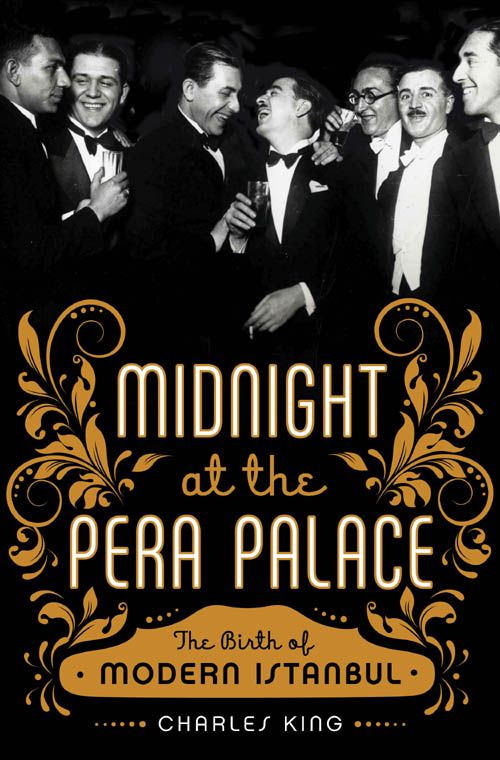Travel Back in Time to 1920s Istanbul with Featured Author Charles King

by Megan Wessell
Megan blogs about books at A Bookish Affair.
Many of the featured authors at the Gaithersburg Book Festival will take attendees to far off places. Charles King is one of those authors. The noted historian has taken readers to far off places such Moldova, Romania and Ukraine. In his latest book, “Midnight at the Pera Palace,” he takes readers to Istanbul, Turkey, during a very turbulent time in the city’s history. The Ottoman Empire is falling and a new nation will be born. Today, Mr. King is here to answer some questions about this great book as well as giving a very sweet answer as to who he would want on a deserted island. King will be at GBF15 on May 16th to answer more of your questions!
You’ve written about many different places. What drew you to write about Istanbul this time around and during the particular time period you chose?
I had already completed a kind of voyage around the Black Sea—having written books on Moldova/Romania, Odessa, the Caucasus and the Black Sea itself—and I thought it was time to turn my attention to the pearl of the Near East, Istanbul itself. I used to go to the Pera Palace Hotel for drinks from time to time in the late 1990s, especially when I was living in Istanbul as a Fulbright Scholar. At that time, the hotel was pretty down-at-heel, with dusty velvet chairs and cracked marble stairs. It was like a faded grande dame who had been through a lot and had learned how to keep a secret. I think at that time I began to form the atom of an idea: that you could somehow tell the history of modern Istanbul—perhaps even part of the history of modern Europe and the Middle East—from the lobby of the hotel. That vantage point also allowed me to do something new for Turkish history-writing specifically: to examine one of the great “blank spots” in the social history of the republic, that is, the first couple of decades after the end of the Ottoman Empire. It’s still a period that is not very well known in Turkey, apart from the life story of Kemal Ataturk, the country’s founder, and so I wanted to try to unpack some myths along the way. The book tries to reach several audiences: travelers, history buffs, professional historians, Turkophiles, spy enthusiasts and people who want to understand the making of the modern Middle East.
I was impressed with how much you were able to cover in this book. It seems like your research must have been daunting! What was your research process like for this book?
I tend to jump into book projects before I really know enough to be a credible historian of a subject. As they say, the greatest way to learn something about a topic is to decide to write a book about it. I also like to jump into the primary sources right away—by reading first-hand memoirs, heading into the archives, and rooting around for telling details outside of the established secondary sources on a topic. I later turn to the secondary materials as a kind of gut-check on my arguments. For this book, I certainly couldn’t have written it without a great deal of on-the-ground research, not least because the secondary histories are pretty thin on this period. It’s also really important for me to go to places I’m writing about and spend time there—seeing, smelling, listening. I’ve been across the Black Sea many times by ship, for example, and in this case I spent a good deal of time walking around Istanbul with a 1934 guidebook I bought from an antiquarian bookseller online. It was like being in a time machine: imagining what might once have stood on a particular spot and trying to “see” the city as it existed in the 1920s-1940s—the era that I call the hidden Islamic jazz age.
In this book, you cover many different aspects of the city. You talk about so many different people, places, and things. How did you choose what to include in “Midnight at the Pera Palace”?
Cutting and editing are always the hardest parts of any project, and in this case my editor and I were rearranging things almost down to the last minute. I believe pretty firmly that the job of a historian is not just to work out the facts of the past and then offer interpretations of it. History, to me, is a way of exercising our moral imagination—to try to see the world as people in a different place and time saw it, and thereby to enlarge our own sense of what humanity is. So, I’m very committed to writing history in such a way that the lives of real people get placed at the front of the narrative. Academic history often privileges big, structural forces in human history, but I’ve been most drawn to the world in a water drop: how something small can reveal monumental things about the human condition. This is sometimes called “micro-history,” and I suppose that’s what I naturally do. I love telling details, small observations, the weird and unexpected facts that come from people’s own experiences, so I try to get as much of that into a book as possible—without, I hope, causing the reader to drown in detail.
What was your favorite part of this book to write?
I loved working on the music sections—trying to imagine what it was like to be in a jazz club in Istanbul in the 1920s or 1930s, say, when a new, hybrid form of music was emerging. Writing about Miss Universe 1932 was also great fun, not least because I got to interview her family (and missed interviewing Keriman Halis herself by only about six months, since she died shortly before I started the project). But it’s really the parts of a story that move me that stick in my memory; that’s what makes a project worthwhile in the end. I was at times moved to tears in reading the stories of Muslims booted out of the Balkans before the First World War, of White Russians desperately escaping the Bolsheviks by coming to Istanbul, of Greeks and Armenians fleeing Turkish nationalists and of Jews seeking refuge in Istanbul during the Holocaust. So much of this book is really about what happens on the far side of awfulness—those times, in the wake of grand historical tragedies, when the losers are forced to restart their lives. That’s what Istanbul did as a city in 1923, when the Turkish Republic was declared but without Istanbul as its capital, and so much of the story of the interwar years is about how both Turks and foreigners were engaged in their own version of exactly the same process.
And now for a fun question, if you could bring any three historical figures with you to a deserted island, who would you bring and why?
I really wouldn’t want to be stranded on a desert island with anyone except my wife, but if I could invite a few historical figures for a weekend in the country, for example, I think a guest list might include: Suleyman the Magnificent, who ruled the Ottoman Empire at its height in the sixteenth century (he would have an interesting perspective on what “civilization” means, since he was a Muslim ruler who was the envy of many European monarchs in that era); Roza Eskenazi (perhaps the greatest musician of the Greek diaspora, a kind of Edith Piaf of the Aegean world); and Freya Stark (the traveler and writer who managed to wedge her centenarian life into the most interesting 100 years possible—the 1890s to the 1990s—and helped create the modern Middle East in the bargain).
 Charles King is the author of “Midnight at the Pera Palace,” “Odessa” and other books on European history and politics. He is Professor of International Affairs and Government at Georgetown University, where he previously served as chairman of the faculty of the Edmund A. Walsh School of Foreign Service. A frequent media commentator on global affairs, King has written for The New York Times, The Washington Post, the Los Angeles Times, Foreign Affairs, the Times Literary Supplement and other publications and has appeared on broadcast media such as NPR, the BBC, CNN and MSNBC.
Charles King is the author of “Midnight at the Pera Palace,” “Odessa” and other books on European history and politics. He is Professor of International Affairs and Government at Georgetown University, where he previously served as chairman of the faculty of the Edmund A. Walsh School of Foreign Service. A frequent media commentator on global affairs, King has written for The New York Times, The Washington Post, the Los Angeles Times, Foreign Affairs, the Times Literary Supplement and other publications and has appeared on broadcast media such as NPR, the BBC, CNN and MSNBC.


